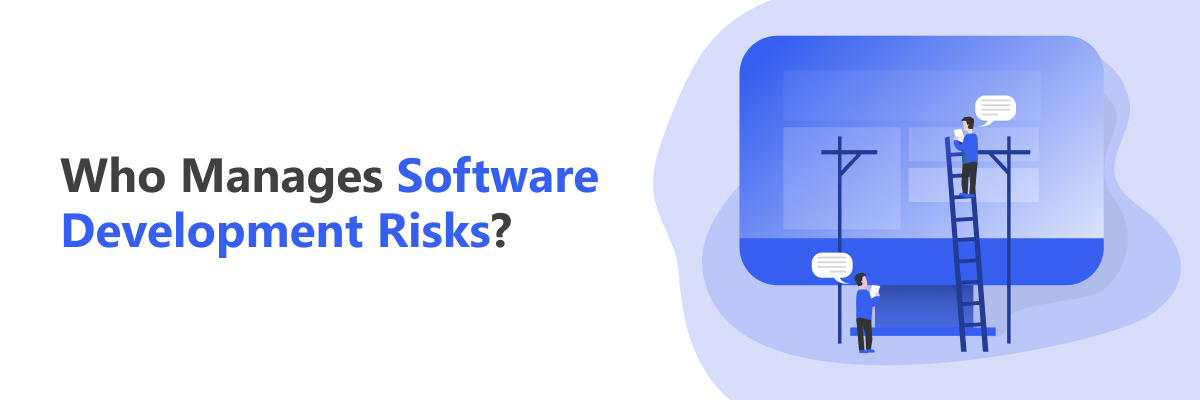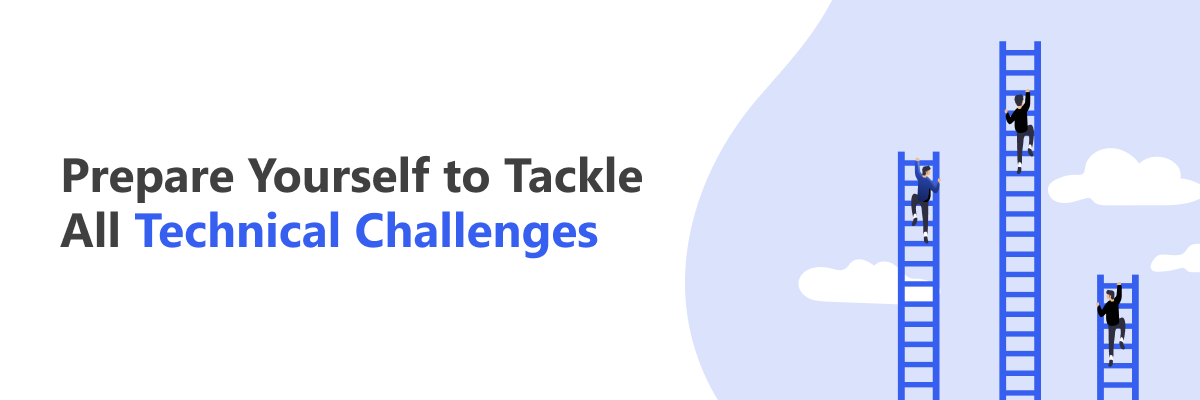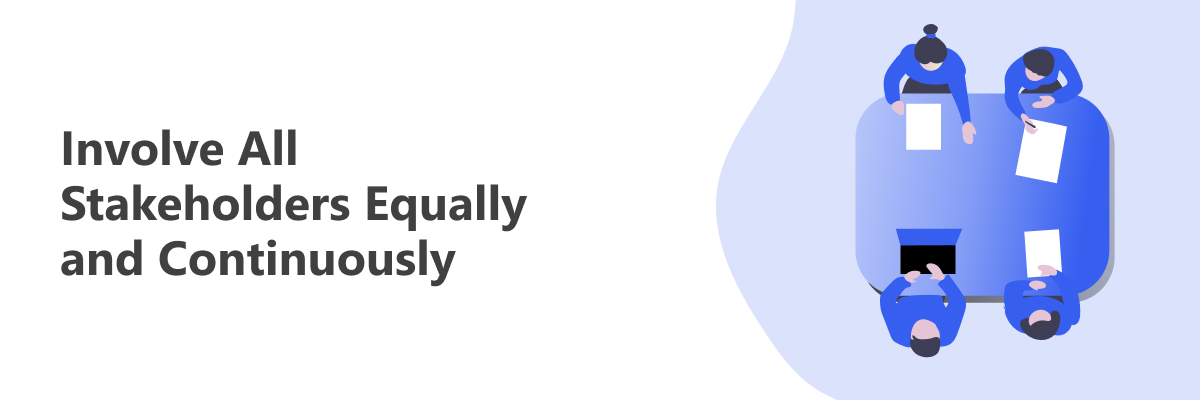There are some things in life that you cannot control. The weather, cats, and the entropy of all living creatures, for a start.
Fortunately, software development risks do not fall under the aforementioned category. You can control, mitigate, and even eliminate the common risks associated with software development to a large extent.
You need to familiarise yourself with the usual pitfalls in mobile app or web app development to manage the associated risks. In this blog, we will first acquaint you with the most frequent software development risks and then outline the different tactics you can adopt to avoid them while developing your product.
So, What Are Risks in Software Development?
Managing a software project is not easy. There are many variables involved, which means the software development process is subject to uncertainty. And any uncertainty that is part of the project constitutes a project risk, as it comprises the ability of the team to guide the project to successful completion.
These risks, or rather, potential problems, need to be managed effectively if you wish to ensure project success.
Suggested Read: 6 Major Reasons Why Software Projects Fail And How To Avoid Them.
What is Risk Management?
Simply put, risk management is the process of dealing with any risk associated with your project. It will involve the following steps:
Identification of the Risk
You must have a basic knowledge of the risks associated with software product development and a keen eye to be able to spot the risks before it’s too late to manage them.
Evaluation of the Risk
What is the severity of the risk? Are it’s adverse effects an immediate threat or can you buy time before the risk becomes a serious danger to your project? Answering these questions will help you with the next step of the risk management process: prioritisation.
Prioritisation of the Risk
When your project faces multiple risks at the same time, you will need to prioritise them in order of urgency and resolve them one by one instead of having a panic attack.
Risk Management
Figure out how you can effectively neutralise the threat a risk poses to your project. Once you have a solution, you need to use your time and resources judiciously to curtail, control, and check the adverse effects of that risk on your mobile or web app development project.
Whose Responsibility Is It to Manage Risks in a Project?

The project manager (that would be you, since you searched for this topic), of course. But, the entire responsibility does not rest with you alone. Your team members are also expected to play their part, however big or small, in mitigating the risks associated with software development.
In fact, every stakeholder in the project must be aware of the most common risks that plague any project development process. Everyone must actively work together to ensure that your project crosses the finish line without any considerable casualties.
As the project manager, it goes without saying that the onus of the project risk management falls on your shoulders.
Awareness about the project risks is not enough to lead your team to victory. You have to successfully prepare yourself to cross every hurdle that stands between you and that glorious sign-off document. This means you need to learn how to assess the risks you identify and figure out how to mitigate or eliminate them effectively.
What Are the Expected Outcomes of Risk Management?
Risk management ultimately leads to one of three outcomes.
If managed successfully, the risk is either eliminated or at least alleviated.
- Some risks, such as improper planning can be eliminated completely. All you need to do is make sure that you invest the time and resources to draw up a proper roadmap for your project process.
- Some risks, such as budget changes, cannot be eliminated completely, as they are not entirely in your control. Such risks can be reduced with airtight contracts in this specific instance.
- And the third, and unfortunate, outcome is that your risk management strategy does not work and the risk still poses a threat to your software development project’s progress.
Do not be disheartened if your first attempt does not hit the risk management jackpot. Simply reassess the risk and try a different tactic that could prove more effective.
Look up the 9 Best Strategies to Optimize Innovation in Product Development.
Common Risks in Software Development and How to Manage Them
Being aware of the risks that go hand in hand with any software product development is a good place to start. So, take a good long look at the following risks that most software developers deal with at least once in their professional careers. Don’t worry, we also tell you how to manage them constructively.
Poor Planning

Ask any software developer to cite the number one risk they expect to face in a new software development project. The most likely answer you will receive is ‘improper or inadequate planning’.
The initial planning that goes into a development project plays a key role in the final outcome of the project. In fact, it can make or break your project.
As the project manager, it falls on you to create a roadmap for your project. This will include careful research and analysis and, yes, planning, from your side. Document a project plan and the scope of the project, the project schedule, any constraints or liabilities, and the possible risks you might have to overcome.
Planning your project gives you more insight into each stage of the project and the time and effort that go into them. The more you plan, the clearer your project path becomes. And the clearer your project path, the easier it will be to guide your project to success.
Of course, you can plan your project down to the T, and still run into speed bumps along the way. Truth be told, it is to be expected. Which means your ideal plan must also leave buffers to keep your project running smoothly and staying on course.
Deadly Deadlines

Unfeasible deadlines could literally mean the death of your project.
If your deadline is unrealistically short, it will make it hard or impossible for your teammates to deliver on time. It will, in turn, bring down the team’s overall morale, affecting all subsequent work adversely. It will also put unnecessary stress on your team members to deliver and might even affect their mental health and wellbeing.
If your deadline is too long, then your project development might lack the seriousness that is required to keep your team motivated. A take-it-easy attitude can creep in, leading to shoddy work and a lack of drive to push your project to the completion phase.
In short, you can avoid deadly deadlines with a simple action plan: don’t overreach.
You need to understand the scope of your project and align it with the efficiency of your team. This will help you draw up a detailed project schedule that your teammates can stick to.
Let’s say you did manage to create an ideal deadline, but it was delayed somehow. You can still manage that risk in multiple ways.
The easiest solution is to simply assign more resources to the tasks that need it. This is called ‘crashing the schedule’, and while it may not result in the greatest efficiency, you can get your project to move faster. Another technique employed by project managers to mitigate risks associated with deadlines is called ‘fast tracking’.
In fast-tracking, your resources work on multiple tasks simultaneously instead of waiting for each task to be completed in sequential order. If all else fails, you can also consider outsourcing some tasks to an external team.
Read about the Top 11 Time Management Tips for Entrepreneurs to boost their Productivity.
Ersatz Estimations

Ersatz estimations, that is, estimations that are of inferior quality, can lead to excessive expectations. And if history is any indicator, excessive expectations do not end well for at least one of the parties involved in a software development project.
Ersatz estimations are estimations that are done hastily and without enough proper research. In essence, these estimations are only good on paper and do not hold up well to scrutiny.
In a software development project, you need to carefully estimate various variables like the time required for completion and the resources necessary for different tasks.
You can estimate a delivery date and a budget for the project based on the information at hand. Once you give an estimate to the client, it creates an expectation that you and your team are supposed to uphold.
It is up to you to ensure that the expectations you create are not unrealistic to avoid bad blood between yourself and the client in the future. The tricky part is dealing with the aftermath if you fail to live up to these expectations.
Accuracy in making your estimations is crucial here. Since the process does involve a bit of guesswork, you need to get your basics right. This, of course, means more research. You also need to draw on your previous project experiences to estimate an accurate delivery date by your team.
Keep the Cone of Uncertainty in mind while making your estimations. Although the number of unknowns will be large at the beginning stages of your project, they reduce to zero as your project progresses and gets more streamlined.
Bungled Budgets

Ah, changing budgets! The bane of any project manager’s existence, especially if the client is particular in nature.
You might have made the right calls while estimating your project budget, but there is still the risk of budget fluctuations as your project progresses. Of course, the budget will almost always increase, which will likely lead to client dissatisfaction.
The most common cause of changing budgets is a sneaky little phenomenon that goes by the name of ‘scope creep’. You can liken it to the barnacles that stick to a ship’s bottom over the years. Nobody really quite wants it there, nobody made any agreements, but it’s there nevertheless.
And it keeps growing, bogging down your ship and increasing your fuel costs. Before you know it, you’re out of a job as a deckhand for not keeping tabs on the barnacle growth.
To understand scope creep, replace the ship with your project, and the barnacles with your project requirements. As the project progresses, you will most likely see new features and functionalities being added to the software you are trying to develop.
It might be because of a well-meaning team member who wants to put your best work forward, or a taciturn client, or just plain miscommunication. The extra additions will translate into more billable hours, resulting in disputes between you and the client if they do not approve it first.
The simplest way to make sure your project is barnacle-free is to check back with your stakeholders often and see if they have any new additions they want to make to the project. You need to make sure these changes go through the proper protocol before they are implemented.
If the additional functionalities improve your final product, you must first run it by your client and get their approval before incorporating them into your project. Let the client choose whether they want to modify the project’s scope or stick to the initial scope. That way, the client is made aware that there will be a budget change, leaving no room for discord.
Short-sighted Scope

No, we are not implying that your scope walks into rooms with a squint and bifocals perched on its nose.
A short-sighted scope focuses only on the immediate needs of your project. It fails to consider the possibility of more project requirements cropping up as the project moves along. So your project will go for a toss if the project scope is expanded after you start the work.
If your project scope did not leave room for additions, it means that your subsequent planning and scheduling also lack buffer room to incorporate the new changes. The ensuing chaos could be highly problematic for your project completion.
A short-sighted scope is a risk that should be nipped in the bud. Wait for it to blossom and your team will likely go into a frenzy trying to squeeze in more man-hours to meet deadlines.
If it’s already too late to adjust your scope, you can always try to mitigate this particular risk by talking to all the stakeholders involved. Make them understand how the new additions to the scope are going to affect your project. Then, dust yourself off and move towards a singular goal as a team.
Technical Trouble

Technical trouble can range anywhere from frequent power cuts to data security problems, and include everything in between. You can eliminate the risk of power failure simply by installing adequate backup generators, but the other risks might be a little harder to tackle.
It is evident that most of the technical risks associated with a software development project can be handled effectively if you understand the risk completely. Understanding the risk will give you an idea about the severity of the risk and how you can innovate to avoid them.
Your team might be handling new or updated technology, which they are unfamiliar with. Or perhaps your team is not accustomed to large-scale system implementations or software integrations. Such a situation could cause technical glitches due to poor execution. You can avoid this situation by ensuring that you deploy the right skilled resources to the right project.
You might face issues with information privacy or data security. This could lead to legal problems for your company. You can eliminate this risk with airtight legal documents and the right compliance solutions.
Or maybe your technical risk is something completely unprecedented because, well, technology is evolving even as you’re reading this. The key here is to stay prepared to face any risk with the right solutioning experts on your side.
Suggested Read: 10 Vital Non-Technical Skills A Software Developer Should Have in 2021.
Careless Coding

The code is the heart and soul of a software development project.
Your team must try to create codes that leave no room for error. And to do that, you shouldn’t simply jump into the coding process and wing it as you move along. Your team must take the time to evaluate the project requirements and get an idea of the expected design outcome, or your project could land in real trouble.
We don’t mean to imply that your development team will willfully indulge in creating poor-quality code. But any number of factors like rushed deadlines or last-minute feature additions could result in poor quality codes. Such codes will mean that your team will have to waste even more time fixing bugs and errors.
Now, this is a risk you can eliminate from the start. Make sure you sit down and have a little chat with your team and understand how they plan to address the following questions, among others.
How should you code for the specific requirements of this project? Which framework is best suited in this case? Which design pattern should you utilise for your use case? Which parts of the code can you reuse effectively? How can you ensure that your coding does not create any technical debts?
If your team makes an effort to decide on a good pattern and framework instead of starting the coding work nilly-willy, you can avoid simple coding errors. Following the proper steps in coding will help you avoid unnecessary codes and code duplication.
Ensure that the code created by your development team is up to industry standards with regular checks. You should also consider implementing User Acceptance Criteria (UAC) to keep your team on their toes throughout the development process.
Poor Productivity

There is no cut and dried method to ensure that your team is at its productive best at all hours of the day. And that is because it’s almost impossible for someone to be productive every minute of every working hour. So, unless your teammates are robots that do not need a break every now and then, you need to accept the fact that there might be occasional dips in productivity.
It becomes a risk to the project development process only when the occasional productivity lows become frequent productivity norms. Any number of factors can cause a decline in productivity, and it can be on an individual level or a team level.
Perhaps your teammates are dissatisfied with some aspect of the management. Perhaps one of your teammates is struggling with a personal problem that is weighing heavily on their mind. Perhaps your team has been working too hard and needs to blow off some steam.
As the project manager, you need to identify these situations and figure out ways to resolve them, as they could pose a risk to your project progress if they escalate. You could have a tête-à-tête with your team if their productivity levels are collectively low.
If you identify a single team member whose productivity graph is nosediving, have a one-on-one chat with them to see if you can fix the issue. You never know, maybe all they need is a small vacation!
It is your responsibility to keep the morale of your team high. Guide them the right way and brainstorm new ways of improving your productivity as a team.
Insufficient Involvement

For a project to be a resounding success, all stakeholders must play an equal role, irrespective of their tasks. It means that the client, the development team, as well as external stakeholders such an investor, must all be in sync with each other. If the stakeholder involvement is low, it can lead to many problems in the later stages of the project development cycle.
The stakeholder involvement must also be consistent from the beginning of the project to the end. It is not practical for the client to pipe up during the deployment stage and say that they are not happy with the design. Or an investor to say they are not happy with the final product when they see it for the first time.
The design concerns must be voiced while the design process is in progress. And the aforementioned investor should keep a close eye on the product as it is being developed. This way, his feedback can be assimilated in the product in a timely fashion.
Take a look at the Top 15 Design Tools For Mobile App Designers
Do not forget to account for your end-users in the iteration processes. At the end of the day, the final product should be appealing to your client’s target audience. Implementing a continuous feedback loop system will help you stay connected to the end-users.
As a project manager, it is your duty to communicate the need for continuous stakeholder investment in the project to all the concerned parties. They are all equally important cogs that keep the machinery running smoothly.
And the malfunction of a single cog can hamper the functioning of the machine. This also builds a sense of accountability in each team member and pushes them to deliver better results with each iteration.
Extraordinary Events

Your planning is impeccable, your team is determined, your client is supportive, and you’re ready to kick your software development into high gear. And then there’s a bright flash of light and a meteorite crashes into the earth, halting the world. Or, more realistically, a pandemic seizes the planet and brings billion-dollar businesses down to their knees overnight.
Even when you are as prepared as can be, there is the unlikely possibility of a natural disaster like earthquakes or floods that can shut down your operations for an indeterminate period of time. This could also be man-made disasters like wars, riots, and strikes, to name a few. These acts of God (and man) can limit your team from functioning normally.
But, you’re still accountable for the project, right? What do you do?
Well, you adapt and try to work from home.
If it’s completely out of your hands, you thank your lucky stars that you thought ahead and added a force majeure clause to your project contract. The force majeure clause will exempt you from fulfilling your contractual obligations to the client until the disaster is averted. Note that it is not a permanent solution. You are still obligated to pick up where you left off once your world returns to its state of normalcy.
Conclusion
No matter how well you plan a project, potential threats to the project delivery will hit you out of the blue. They could be related to your resources, the technology you work with, or just a case of the Monday blues leading to low productivity.
And these risks can be just as unpleasant as a wet sock to your face unless you are prepared to dodge them. Take the necessary precautions to manage and mitigate the possible risks in a timely manner, and you’re good to go.
At NeoITO, we make sure that your project does not start before we have analysed and mitigated the associated risks. This way, we ensure that you get the best value for your investment with us. See our services to get a better grasp of what we can offer.




